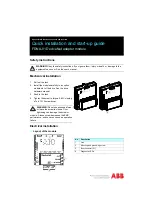
BusWorks® Model 989EN U
ser’s Manual Modbus TCP/IP Digital I/O & Counters
_________________________________________________________________________________
_______________________________________________________________________________________
Acromag, Inc. Tel:248-295-0880 Fax:248-624-9234 Email:
17
The
Modbus Port Number
is set to port 502 by default, which has been
reserved for Modbus applications. Port numbers represents an endpoint or
“channel” for network communications. In this way, every IP address is
divided into many ports, and when one computer sends data to another
computer, it sends the data from a port of an IP address to a port on another
IP address. Any one port can only be used by one program at a time. The
use of port numbers allows different applications on the same computer to
utilize network resources without interfering with one another. The port
number could range from 0-99999, but most popular applications will use
port numbers at the low end of this range already set aside for specific
applications (such as 502 for Modbus, or 80 for HTTP). For example, ports
make it possible for you to check your email and browse the web at the
same time, because web browsers use port 80, while retrieving your email
uses port 110.
A
Subnet Mask
is used to subdivide the host portion of the IP address into
two or more subnets. The subnet mask will flag the bits of the IP address
that belong to the network address, and the remaining bits correspond to the
host portion of the address. The unique subnet to which an IP address
refers to is recovered by performing a bitwise AND operation between the IP
address and the mask itself, with the result being the sub-network address.
Gateway
refers to the IP Address of the gateway, if your local area network
happens to be isolated by a gateway. Typically, it is assigned the first host
address in the subnet. If a gateway is not present, then this field should
contain an unused address within the host subnet address range.
The
Active IP Address
refers to the current IP Address being used by this
host, as opposed to any new assignments being made via this page.
The
MAC Address
refers to the Media Access Control Address that
uniquely identifies the hardware of this device. This is a unique fixed
address assigned to this module at the factory. In IEEE 802 networks, the
Data Link Control (DLC) layer of the OSI Reference Model is divided into two
sublayers: the Logical Link Control (LLC) layer, and the Media Access
Control (MAC) layer. The MAC layer interfaces directly with the network
media (each different type of network media requires a different MAC layer).
By default, the module is setup to use
Static IP Addressing and a Static IP
Address of 128.1.1.100
. You can optionally choose to have the IP address
assigned dynamically via DHCP, or DHCP w/Fallbacks. This will also
require that you specify a valid Host Name. Note that DHCP w/Fallback will
revert to the static IP address if your DHCP server cannot be found at the
address specified.
DHCP
(Dynamic Host Configuration Protocol) refers to a protocol for
assigning dynamic IP addresses to devices on a network. With dynamic
addressing, a device can have a different IP address every time it connects
to the network. In some systems, it can even change while it is still
connected. DHCP also supports a combination of static and dynamic IP
addresses. For example, DHCP with fallback will revert to a static IP
address if the DHCP server cannot be found.
WEB BROWSER
Network Configuration
The Default Communication
Mode uses a static IP address
of “128.1.1.100”, a default
subnet mask of
“255.255.255.0”, a default
username of “User”, and a
default password of
“password”.
















































